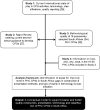Next generation clinical guidance for primary care in South Africa - credible, consistent and pragmatic
- PMID: 29601611
- PMCID: PMC5877861
- DOI: 10.1371/journal.pone.0195025
Next generation clinical guidance for primary care in South Africa - credible, consistent and pragmatic
Abstract
Background: Agreed international development standards underpin high quality de novo clinical practice guidelines (CPGs). There is however, no international consensus on how high quality CPGs should 'look'; or on whether high quality CPGs from one country can be viably implemented elsewhere. Writing de novo CPGs is generally resource-intensive and expensive, making this challenging in resource-poor environments. This paper proposes an alternative, efficient method of producing high quality CPGs in such circumstances, using existing CPGs layered by local knowledge, contexts and products.
Methods: We undertook a mixed methods case study in South African (SA) primary healthcare (PHC), building on findings from four independent studies. These comprised an overview of international CPG activities; a rapid literature review on international CPG development practices; critical appraisal of 16 purposively-sampled SA PHC CPGs; and additional interrogation of these CPGs regarding how, why and for whom, they had been produced, and how they 'looked'.
Results: Despite a common aim to improve SA PHC healthcare practices, the included CPGs had different, unclear and inconsistent production processes, terminology and evidence presentation styles. None aligned with international quality standards. However many included innovative succinct guidance for end-users (which we classified as evidence-based summary recommendations, patient management tools or protocols). We developed a three-tiered model, a checklist and a glossary of common terms, for more efficient future production of better quality, contextually-relevant, locally-implementable SA PHC CPGs. Tier 1 involves transparent synthesis of existing high quality CPG recommendations; Tier 2 reflects local expertise to layer Tier 1 evidence with local contexts; and Tier 3 comprises tailored locally-relevant end-user guidance.
Conclusion: Our model could be relevant for any resource-poor environment. It should reduce effort and costs in finding and synthesising available research evidence, whilst efficiently focusing scant resources on contextually-relevant evidence-based guidance, and implementation.
Conflict of interest statement
Figures
Similar articles
-
Barriers and enablers for the development and implementation of allied health clinical practice guidelines in South African primary healthcare settings: a qualitative study.Health Res Policy Syst. 2017 Sep 15;15(1):79. doi: 10.1186/s12961-017-0243-3. Health Res Policy Syst. 2017. PMID: 28915890 Free PMC article.
-
South African primary health care allied health clinical practice guidelines: the big picture.BMC Health Serv Res. 2018 Jan 29;18(1):48. doi: 10.1186/s12913-018-2837-z. BMC Health Serv Res. 2018. PMID: 29378586 Free PMC article.
-
Standardising evidence strength grading for recommendations from multiple clinical practice guidelines: a South African case study.Implement Sci. 2018 Aug 29;13(1):117. doi: 10.1186/s13012-018-0803-0. Implement Sci. 2018. PMID: 30157898 Free PMC article.
-
Representations of clinical practice guidelines and health equity in healthcare literature: An integrative review.J Nurs Scholarsh. 2023 Mar;55(2):506-520. doi: 10.1111/jnu.12847. Epub 2022 Nov 23. J Nurs Scholarsh. 2023. PMID: 36419399 Review.
-
Harmonization of clinical practice guidelines for primary prevention and screening: actionable recommendations and resources for primary care.BMC Prim Care. 2024 May 6;25(1):153. doi: 10.1186/s12875-024-02388-3. BMC Prim Care. 2024. PMID: 38711031 Free PMC article. Review.
Cited by
-
Contextualised strategies to increase childhood and adolescent vaccination coverage in South Africa: a mixed-methods study.BMJ Open. 2020 Jun 4;10(6):e028476. doi: 10.1136/bmjopen-2018-028476. BMJ Open. 2020. PMID: 32503865 Free PMC article.
-
Extending the RIGHT statement for reporting adapted practice guidelines in healthcare: the RIGHT-Ad@pt Checklist protocol.BMJ Open. 2019 Sep 24;9(9):e031767. doi: 10.1136/bmjopen-2019-031767. BMJ Open. 2019. PMID: 31551391 Free PMC article.
-
A user-friendly clinical practice guideline summary for managing low back pain in South Africa.S Afr J Physiother. 2020 Feb 20;76(1):1366. doi: 10.4102/sajp.v76i1.1366. eCollection 2020. S Afr J Physiother. 2020. PMID: 32161826 Free PMC article.
-
Development of an innovative strategy to determine functioning attributed to health conditions in low-resource settings.Digit Health. 2022 Dec 13;8:20552076221144213. doi: 10.1177/20552076221144213. eCollection 2022 Jan-Dec. Digit Health. 2022. PMID: 36532110 Free PMC article.
-
Clinical practice guideline adaptation methods in resource-constrained settings: four case studies from South Africa.BMJ Evid Based Med. 2020 Dec;25(6):193-198. doi: 10.1136/bmjebm-2019-111192. Epub 2019 Jul 10. BMJ Evid Based Med. 2020. PMID: 31292208 Free PMC article.
References
-
- Field M J, Lohr KN. Clinical practice guidelines: directions for a new program Institute of Medicine, Washington DC, National Academy Press; 1990: 38. - PubMed
-
- Graham R, Mancher M, Miller Wolman D, Greenfield S, Steinberg E. Clinical Practice Guidelines We Can Trust Institute of Medicine, Committee on Standards for Developing Trustworthy Clinical Practice Guidelines (IOM 2011). The National Academies Press, Washington, D.C; 2011: 15. - PubMed
-
- National Institute for Health and Care Excellence www.nice.org.uk (accessed Feb 20th, 2018).
-
- Scottish Intercollegiate Guidelines Network www.sign.org.uk (accessed Feb 20th, 2018).
Publication types
MeSH terms
Grants and funding
LinkOut - more resources
Full Text Sources
Other Literature Sources




